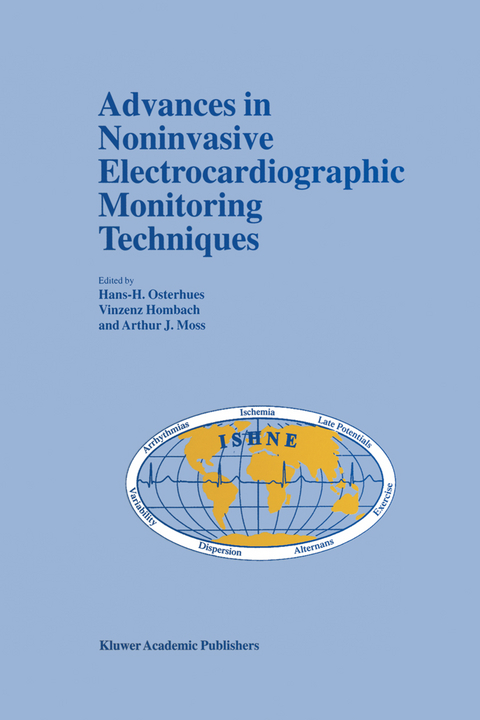
Advances in Noninvasive Electrocardiographic Monitoring Techniques
Springer (Verlag)
978-0-7923-6214-2 (ISBN)
Noninvasive electrocardiographic monitoring is a fundamental part of cardiology. Depending on continuous improvements and developments of new technologies, these methods are essential for diagnosis and risk stratification of patients. The rapid changes in the capabilities, technologies and diagnostic values of the different methods force us to update our knowledge continuously.
This book offers a comprehensive overview of the current state and future developments in the field of noninvasive electrocardiographic monitoring techniques. In addition, related fields such as magnetocardiography, newer signal detection and analysis techniques as well as ambulatory blood pressure monitoring are reported. The different methods are discussed with regard to methodological aspects, latest technical developments and clinical value of results. Furthermore, review articles focus on the autonomic nervous system, monitoring of ischemic heart disease, quality control and standardization of monitoring techniques.
A group of international experts in science and clinical practice have contributed to this book, which is supported by the International Society for Holter and Noninvasive Electrocardiography (ISHNE). The book is addressed to clinical and academic cardiologists as well as scientists.
One: Physiology and Pathophysiology.- Section one: Basic Research: From Gene to Phenotype.- Cardiovascular molecular genetics.- Dilated cardiomyopathy and arrhythmogenic right ventricular dysplasia: From gene to phenotype.- Heart failure: From gene to therapy.- Section two: Autonomic Nervous System.- Autonomic Nervous System: Physiology and pathophysiology.- Methods to assess baroreflex sensitivity as a measure of the activity of the autonomic nervous system.- Role of the Autonomic Nervous System in cardiovascular diseases.- Therapeutical options to influence the autonomic nervous system.- Two: ECG aspects investigated by different methods.- Section one: P-wave and QRS.- The signal averaged P-wave.- Wenckebach pattern of ventricular late potentials.- Detection of QRS-variability.- Section two: QT-variability/QT dispersion.- QT-Dispersion: Role in clinical decision making.- Dynamic QT-interval analysis.- QT-variability: Clincial results and prognostic significance.- Heart rate dependency of QT-interval in congenital and acquired prolonged ventricular repolarisation: Long-term analysis by Holter Monitoring.- Section three: T-wave alternans/repolarization.- Modern approaches to assessment of ventricular repolarisation.- Dynamicity of T-wave alternans: Measurement and role in sudden death.- Macrovolt T-wave alternans: pathophysiology and link with repolarization-dispersion.- T-wave alternans and variability: prognostic, diagnostic and therapeutic implications.- Three: Focus on: Ischemic Heart Disease.- Non-invasive quantification/localisation of myocardial ischemia.- Ambulatory ECG, myocardial ischemia and risk stratification.- Post thrombolysis/post PTCA-monitoring.- Interactive Holter-monitoring of transient ischemic episodes.- Silent ischemia: The 1998 status: new observations on triggers, pathophysiological mechanisms and circadian variations.- Circadian variation in myocardial ischemia and infarction.- Chronopharmacology — Implications for diagnosis and treatment.- Beta blockers following acute myocardial infarction.- The United States Multicenter Study of enhanced external counterpulsation (MUST-EECP).- Four: Methods.- Section one: Quality control and standardization of monitoring techniques.- Heart rate variability: A simple methodology with several unrecognized technical and methodological problems.- Quality control and standardization: High resolution ECG.- Section two: Exercise ECG.- Diagnosis of myocardial viability: Contribution of the ECG.- Exercise testing for risk stratification.- Cardiopulmonary exercise testing: cardiovascular and respiratory limitations detected by exercise gas exchange.- Section three: Ambulatory Blood Pressure Monitoring.- White-coat hypertension: State of the art.- Should antihypertensive treatment be guided by casual measurement or through Ambultory Blood Pressure Monitoring.- Non-invasive pulse wave velocity as a method to evaluate physical properties of the large arteries in aging and hypertension.- Prognostic implications of blood pressure variability.- Section four: Magnetocardiography.- Magnetocardiographic technology: State of the art.- Ischemia and hibernation in magnetocardiography.- MCG at the turn of the millennium.- Five: Analysis Techniques.- Section one: Non-linear dynamics.- Methods of non-linear dynamics.- Heart rate variability and non-linear dynamics.- Symbolic dynamics.- Section two: Newer signal detection and analysis techniques.- Neural classification in high-resolution ECG signal processing.- Cardiovascular system identification.- Maximum likelihood analysis in ECG signalprocessing.- What can cardiac computer models tell us about arrhythmogenesis.
| Reihe/Serie | Developments in Cardiovascular Medicine ; 229 |
|---|---|
| Zusatzinfo | XXII, 498 p. |
| Verlagsort | Dordrecht |
| Sprache | englisch |
| Maße | 155 x 235 mm |
| Themenwelt | Mathematik / Informatik ► Mathematik |
| Medizinische Fachgebiete ► Innere Medizin ► Kardiologie / Angiologie | |
| Studium ► Querschnittsbereiche ► Epidemiologie / Med. Biometrie | |
| ISBN-10 | 0-7923-6214-4 / 0792362144 |
| ISBN-13 | 978-0-7923-6214-2 / 9780792362142 |
| Zustand | Neuware |
| Haben Sie eine Frage zum Produkt? |
aus dem Bereich


